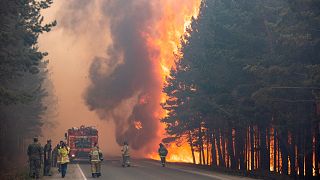Russia deploys military to help contain raging Siberian wildfire
By AP • Updated: 23/07/2021 -

In this June 16, 2021 photo, firefighters work at the scene of forest fire near Andreyevsky village outside Tyumen, western Siberia, Russia. - Copyright AP Photo/Maksim Slutsky, File
Russia's military was on Thursday deployed to held contain raging wildfires in the country's Sakha-Yakutia region.
More than 1.5 million hectares (3.7 million acres) of land have so far been scorched in the Siberian region since the beginning of summer with hundreds of wildfires sparked by record temperatures.
The vast region has had a long spell of extremely hot and dry weather this summer, with temperatures reaching 39 degrees Celsius and setting records for several days.
The fires have shrouded Yakutia's cities, towns and villages in thick smoke, forcing authorities to briefly suspend flights at the regional capital's airport. The defense ministry deployed transport planes and helicopters to help douse the flames.
The Russian Air Force made 18 flights, dropping 36 tons of water on the blazes in the Gorny district.
Fedot Tumusov, a member of the Russian parliament who represents the region, called the blazes “unprecedented” in their scope.
The forests that cover huge areas of Russia make monitoring and quickly spotting new fires a daunting task.
In 2007, a federal network to spot fires from aircraft was disbanded and had its assets turned over to regional authorities. The much-criticised change resulted in the programme's rapid deterioration.
The government later reversed the move and reestablished the federal agency in charge of monitoring forests from the air. However, its resources remain limited, making it hard to survey the massive forests of Siberia and the Far East.
Record heat in northwestern Russia, Siberian wildfire season kicks off early
'We can’t see each other': Fires rage across Siberia amid dryest summer in 150 years
While some wildfires are sparked by lightning, experts estimate that over 70% of them are caused by people, from carelessly discarding cigarettes to abandoned campfires, but there are other causes.
Some wildfires are sparked by authorities in controlled burns to clear the way for new vegetation or to deprive unplanned wildfires of fuel. Observers say such intentional burns often are poorly managed and sometimes trigger bigger blazes instead of containing them.
Observers say such intentional burns often are poorly managed and sometimes trigger bigger blazes instead of containing them.
Farmers also use the same technique to burn grass and small trees on agricultural lands. Such burns regularly get out of control.
Activists and experts say that fires are also often set deliberately to cover up evidence of illegal lumbering or to create new places for timber harvesting under the false pretext of clearing burned areas.
Activists in Siberia and the Far East allege such arson is driven by strong demand for timber in the colossal Chinese market, and they have called for a total ban on timber exports to China.
Officials have acknowledged the problem and pledged to tighten oversight, but Russia's far-flung territory and regulatory loopholes make it hard to halt the illegal activity.
Critics blame the 2007 forest code that gave control over timberlands to regional authorities and businesses, eroding centralised monitoring, fueling corruption and contributing to illegal tree-cutting practices that help spawn fires.
No comments:
Post a Comment